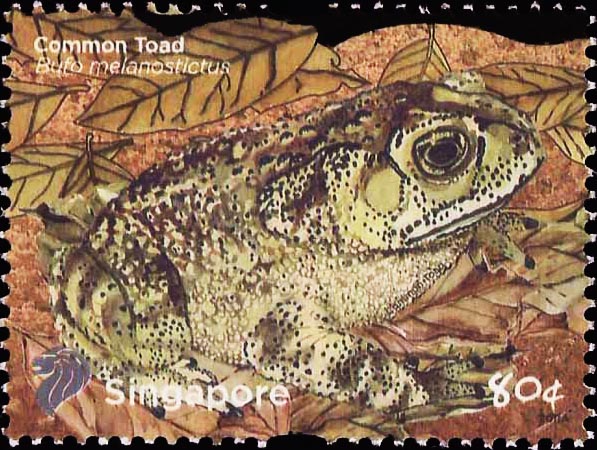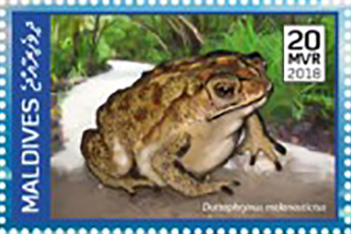Duttaphrynus melanostictus Schneider, 1799)

(Da: en.wikipedia.org)
Phylum: Chordata Haeckel, 1874
Subphylum: Vertebrata J-B. Lamarck, 1801
Classe: Amphibia Gray 1825
Ordine: Anura Duméril, 1806
Famiglia: Bufonidae Gray, 1825
Genere: Duttaphrynus Frost et al., 2006
English: Asian common toad, Asian black-spined toad, Asian toad, black-spectacled toad, Sunda toad, Javanese toad
Français: Crapaud masqué
Deutsch: Schwarznarbenkröte
Descrizione
La specie cresce fino a circa 20 cm di lunghezza. Rospi comuni asiatici si riproducono durante il monsone e i loro girini sono neri. Giovani rospi possono essere visti in gran numero dopo la fine delle piogge monsoniche.
Diffusione
L'areale della specie si estende attraverso l'Asia meridionale, dal Pakistan, Nepal, Sikkim e Bangladesh, attraverso India, Sri Lanka, isole Andamane, Maldive, sino alla Cina meridionale (compresa Taiwan) e a sud in Malaysia, Sumatra, Giava, Borneo e Bali; è stata inoltre introdotta in Sulawesi, Timor Est, Madagascar e Papua Nuova Guinea. La si trova dal livello del mare sino a 1.800 m di altitudine.
Sinonimi
= Bufo melanostictus Schneider, 1799 (protónimo) = Bufo chlorogaster Daudin, 1802 = Rana dubia Shaw, 1802 = Bufo scaber Daudin, 1802 = Bufo bengalensis Daudin, 1802 = Bufo flaviventris Daudin, 1802 = Bufo carinatus Gray, 1830 = Bufo isos Lesson, 1834 = Bufo gymnauchen Bleeker, 1858 = Docidophryne spinipes Fitzinger, 1861 "1860" = Bufo longecristatus Werner, 1903 = Bufo tienhoensis Bourret, 1937 = Bufo camortensis Mansukhani & Sarkar, 1980 = Ansonia kamblei Ravichandran & Pillai, 1990 = Bufo melanostictus ssp. hazarensis Khan, 2001.
Bibliografia
–van Dijk, P. P.; et al. (2004). "Duttaphrynus melanostictus". IUCN Red List of Threatened Species. 2004.
–Boulenger, G. A. (1890). Reptilia and Batrachia. Fauna of British India. London: Taylor and Francis. pp. 505–507.
–Berry, P. Y.; Bullock, J. A. (1962). "The Food of the Common Malayan Toad, Bufo melanostictus Schneider". Copeia. 1962 (4): 736-741.
–Saidapur, S. K.; Girish, S. (2001). "Growth and Metamorphosis of Bufo melanostictus Tadpoles: Effects of Kinship and Density". Journal of Herpetology. 35 (2): 249-254.
–Saidapur, S. K.; Girish, S. (2000). "The Ontogeny of Kin Recognition in Tadpoles of the Toad Bufo melanostictus (Anura; Bufonidae)". Journal of Biosciences. 25 (3): 267-273.
–R., Arnaud (2014-04-17). "Invasion de crapauds venimeux à Toamasina: une menace pour l'écosystème malgache". Midi Madagasikara.
–Pearson, Richard G.; ‘Asian common toads in Madagascar: an urgent effort to inform surveys and eradication efforts’; Global Change Biology, 21 (2015), p. 9.
–Ujvaria, Beata; Mun, Hee-chang; Conigrave, Arthur D.; Bray, Alessandra; Osterkamp, Jens; Halling, Petter and Madsen, Thomas ‘Isolation breeds naïvety: island living robs Australian varanid lizards of toad-toxin immunity via four-base-pair mutations’; Evolution, vol. 67 (2013) pp. 289-294.
–Ujvaria, Beata; Casewell, Nicholas R.; Sunagar, Kartik; Arbuckle. Kevin; Wüster, Wolfgang; Log, Nathan; O’Meally, Denis; Beckmann, Christa; King, Glenn F.; Deplazes, Evelyne and Madsena, Thomas; ‘Widespread convergence in toxin resistance by predictable molecular evolution’; Proceedings of the National Academy of Sciences of the United States of America, volume 112, pp. 11911-11916.
–Garcia de Jesus, Erin (October 2, 2020). "This snake rips a hole in living toads' stomachs to feast on their organs". Science News. Retrieved 2020-10-13.
–Marshall, Benjamin Michael; Casewell, Nicholas R.; Vences, Miguel; Glaw, Frank; Andreone, Franco; Rakotoarison, Andolalao; Zancolli, Giulia; Woog, Friederike; Wüster, Wolfgang (June 2018). "Widespread vulnerability of Malagasy predators to the toxins of an introduced toad". Current Biology. 28 (11): R654-R655.
–"Toxic toad invasion puts Madagascar's predators at risk, genetic evidence confirms". ScienceDaily.
–See Price-Rees, Samantha J.; Brown, Gregory P. and Shine, Richard; ‘Interacting Impacts of Invasive Plants and Invasive Toads on Native Lizards’, in The American Naturalist vol. 179, No. 3 (March 2012), pp. 413-422.
–Reilly, Sean B.; Wogan, Guinevere O. U.; Stubbs, Alexander L.; Arida, Evy; Iskandar, Djoko T. and McGuire Jimmy A.; ‘ Toxic toad invasion of Wallacea: A biodiversity hotspot characterized by extraordinary endemism’; Global Change Biology; August 2017, pp. 1-3.
–Frazier, S. (Dec 15, 2011). "Asian Common Toad". Project Noah. 8077245.
–Frazier, S. (Jun 13, 2011). "Southeast Asian Toad, Asian Common Toad, Spectacled Toad". Project Noah. 6894260.
–Covacevich, Jeanette, and Archer, Mike; ‘The distribution of the cane toad, Bufo marinus in Australia and its effects on indigenous vertebrates’; Memoirs of the Queensland Museum, volume 17 (1975), pp. 305-310.
–Henderson W, Bomford M. 2011. Detecting and preventing new incursions of exotic animals in Australia. Invasive Animals Cooperative Research Centre, Canberra.
–Sydney Morning Herald, March 28, 2015, ‘Northern Sydney faces Asian black-spined toad plague’.
–Page A, Kirkpatrick W, Massam M. 2008. Black-spined Toad (Bufo melanostictus) Risk Assessments for Australia; Department of Agriculture and Food: Western Australia.

|
Data: 15/04/2011
Emissione: La biodiversità nell'ecosistema dello stagno Stato: Singapore Nota: Emesso in una serie di 8 v. diversi |
|---|

|
Data: 01/04/2018
Emissione: Fauna selvatica dell'Oceano Indiano Fauna selvatica dell'Oceano Indiano Stato: Maldives Nota: Emesso in un foglietto di 4 v. diversi |
|---|